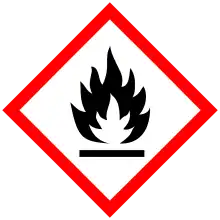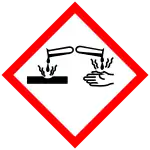 | |
| Names | |
|---|---|
| IUPAC name
2,2-dimethylpropan-1-amine | |
| Identifiers | |
3D model (JSmol) |
|
| ChemSpider | |
| ECHA InfoCard | 100.024.890 |
| EC Number |
|
PubChem CID |
|
| UNII | |
CompTox Dashboard (EPA) |
|
| |
| |
| Properties | |
| C5H13N | |
| Molar mass | 87.166 g·mol−1 |
| Appearance | colorless liquid |
| Density | 0.74 g/cm3 |
| Melting point | −70 °C (−94 °F; 203 K) |
| Boiling point | 80–82 °C (176–180 °F; 353–355 K) |
| Hazards | |
| Occupational safety and health (OHS/OSH): | |
Main hazards |
Irritant, Flammable, Corrosive |
| GHS labelling: | |
   | |
| Danger | |
| H225, H302, H314 | |
| P210, P233, P240, P241, P242, P243, P260, P264, P270, P280, P301+P312, P301+P330+P331, P303+P361+P353, P304+P340, P305+P351+P338, P310, P321, P330, P363, P370+P378, P403+P235, P405, P501 | |
| Flash point | -13 |
Except where otherwise noted, data are given for materials in their standard state (at 25 °C [77 °F], 100 kPa).
Infobox references | |
Neopentylamine is an organic compound with the molecular formula (CH3)3CCH2NH2. It is a colorless liquid. The molecule is the primary amine derivative of neopentane, (CH3)4C.
Synthesis
Neopentylamine is prepared by the reaction of neopentyl alcohol with ammonia in the presence of a hydrogenation catalyst.[2]
Use
It is a common building block.[3] For example, some experimental drugs incorporate this amine.[4][5]
References
- ↑ "Neopentylamine 5813-64-9 | Tokyo Chemical Industry UK Ltd". www.tcichemicals.com. Retrieved 2021-03-01.
- ↑ US 4495369, Werner, Friedrich; Blank, Heinz U. & Gramm, Gunther et al., "Process for the preparation of neopentylamine", published 1985-01-22, issued 1981-09-22, assigned to Bayer AG
- ↑ "Neopentylamine Safety Data Sheet". Fisher Scientific. Retrieved March 1, 2021.
- ↑ Biamonte, Marco A.; Shi, Jiandong; Hong, Kevin; Hurst, David C.; Zhang, Lin; Fan, Junhua; Busch, David J.; Karjian, Patricia L.; Maldonado, Angelica A.; Sensintaffar, John L.; Yang, Yong-Ching; Kamal, Adeela; Lough, Rachel E.; Lundgren, Karen; Burrows, Francis J.; Timony, Gregg A.; Boehm, Marcus F.; Kasibhatla, Srinivas R. (2006). "Orally Active Purine-Based Inhibitors of the Heat Shock Protein 90". Journal of Medicinal Chemistry. 49 (2): 817–828. doi:10.1021/jm0503087. PMID 16420067.
- ↑ Fraser, Robert R.; Mansour, Tarek S. (1984). "Acidity measurements with lithiated amines: Steric reduction and electronic enhancement of acidity". The Journal of Organic Chemistry. 49 (18): 3442–3443. doi:10.1021/jo00192a059.
This article is issued from Wikipedia. The text is licensed under Creative Commons - Attribution - Sharealike. Additional terms may apply for the media files.